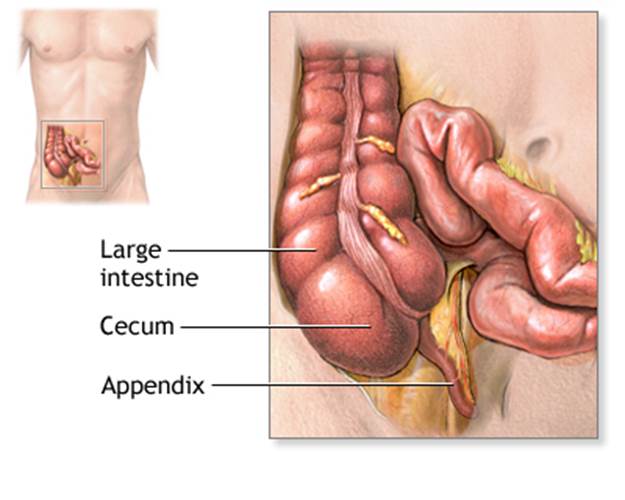Appendicitis in adults
Appendicitis is swelling (inflammation) of the appendix. The appendix is a small pouch attached to the large intestine.

The appendix is a small, finger-shaped pouch of intestinal tissue arising from the cecum near its junction with the small intestine.
Causes
Appendicitis is a very common cause of emergency surgery. The problem most often occurs when the appendix becomes blocked by feces, a foreign object, or rarely, a tumor.
Symptoms
The symptoms of appendicitis can vary. It can be hard to diagnose appendicitis in young children, the elderly, and women of childbearing age.
The first symptom is often pain around the belly button. Pain may be minor at first, but becomes more sharp and severe. You may also have a loss of appetite, nausea, vomiting, and a low fever.
The pain tends to move into the right lower part of your belly. The pain tends to focus at a spot directly above the appendix called McBurney's point. This most often occurs 12 to 24 hours after the illness starts.
If your appendix breaks open (ruptures), you may have less pain for a short time and you may feel better. However, the pain soon gets worse and you will feel sicker.
Your pain may be worse when you walk, cough, or make sudden movements. Later symptoms include:
- Chills and shaking
- Hard stools
- Diarrhea
- Fever
- Nausea and vomiting
Exams and Tests
How you describe your symptoms can lead your doctor to suspect appendicitis.
Your doctor will also examine you.
- If you have appendicitis, your pain will increase when the doctor gently presses on your lower right belly area.
- If your appendix has ruptured, touching the belly area may cause a lot of pain and lead you to tighten your muscles.
- A rectal exam may find tenderness on the right side of your rectum.
A blood test will often show a high white blood cell count. Imaging tests may also help diagnose appendicitis. Imaging tests include:
- CT scan of the abdomen
- Ultrasound of the abdomen
Treatment
Most of the time, a surgeon will remove your appendix as soon as you are diagnosed.
If a CT scan shows that you have an abscess, you may be treated with antibiotics first. You will have your appendix removed after the infection and swelling have gone away.
The tests used to diagnose appendicitis are not perfect. As a result, the operation may show that your appendix is normal. In that case, the surgeon will remove your appendix and explore the rest of your abdomen for other causes of your pain.
Outlook (Prognosis)
Most people recover quickly after surgery if the appendix is removed before it ruptures.
If your appendix ruptures before surgery, recover may take longer. You are also more likely to develop or problems, such as:
- An abscess
- Blockage of the intestine
- Infection inside the abdomen (peritonitis)
- Infection of the wound after surgery
When to Contact a Medical Professional
Call your health care provider if you have abdominal pain in the lower-right portion of your belly, or other symptoms of appendicitis.

